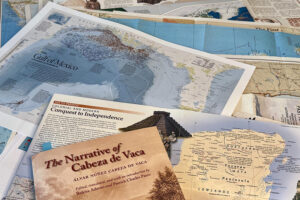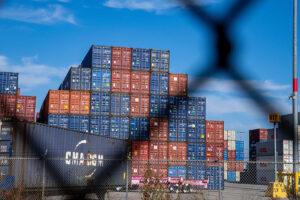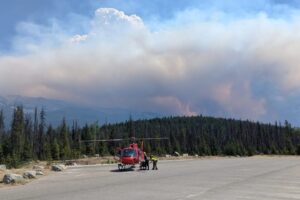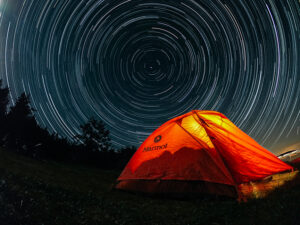While some may argue that the best adventure photography gear is whatever is in your pocket or around your neck, you can learn a lot from examining what the pros use.
Alex Honnold back to the wall, perching ropeless on a thin ledge. Killian Jornet rendered motionless as he hares along a knife-edge ridge. A blurred Jeremy Jones barreling down a steep couloir. Thanks to social media platforms like Instagram, we’ve become familiar with good outdoor imagery. But that kind of work takes more than just a GoPro and an afternoon in the mountains. It requires skill, good planning, and the ability to safely balance participation with photography. And a high-quality camera system helps. But what should you invest in, if you dream to shoot like the pros one day?
ExWeb caught up with two world-renowned adventure and landscape photographers, Pat Morrow and Janis Kraulis, for their take on what cameras and lenses they prefer.
Pat Morrow
The second Canadian to summit Everest, and the first person to do the Seven Summits (Carstensz Pyramid version), Morrow has spent his life shooting mountain culture, climbing, skiing, hiking, rafting, caving, and canyoneering. He once even spent three days cooped up in a hut at -50˚C in the Canadian Arctic with Ed Hillary and Neil Armstrong.
As Morrow is an active participant in the adventures he shoots, his go-to camera for any backcountry outing where weight is an issue is the small but powerful Sony A6600. He also owns a full-frame Sony A7 RIV and Sony FE 24-105MM f/4 G OSS lens, which he considers ideal for all-round mountain photography and videography, but he’s most enthusiastic about the A6600 and its quality lenses.

Kirstin Bartsch and Corinna Strauss prepare to descend the scary snow-plastered choss on Redtop Mountain (3,156m), Purcell Range, British Columbia. All of Morrow’s photos in this article were shot in the past year, with either the A6600 or the A7 RIV. Can you spot the difference? Photo: Pat Morrow
Morrow’s Sony A6600 and Lens Picks:
Cost: $1,300 (body only)
Weight (body only + battery): 503 g
Core Features: 24MP APS-C CMOS sensor, 4K video capture, 810-shot battery life, 5 axis In-body image stabilization, subject-tracking autofocus, articulated tilting LCD screen.
Wide-angle zoom: Sony 16-55mm f/2.8G (used for shooting climbing). $1,300.
Telephoto zoom: Sony E 70-350mm f/4.5-6.3 G OSS Lens (used for ski photography). $900
Portrait lens: Sony FE 135mm f/1.8 GM. $2,100.

Sony A6600 with the Sony 16-55mm F2.8G lens
The A6600 is Sony’s flagship APS-C camera, with a crop sensor that gives a resolution of 24MP. While some crop sensor mirrorless cameras offer up to 32MP, 24MP is more than enough for a professional-quality image, which is typically a file of at least 35mb in tiff format. The key feature of the A6600 and other top-of-the-range APS-C mirrorless models is its compact size.

Morrow shot this low-light scene on a tripod at Mong-la, Nepal with sunlit Kangtega and Thamserku in the background. Photo: Pat Morrow
Pre-digital, “back in the day” Morrow used a tiny Rollie 35 point and shoot camera, with its limiting but tack-sharp fixed 40mm lens. On mountains like Denali, he kept it warm in a jacket pocket. For the same reason, Morrow chose the pocketable Pentax MX on over 20 high-altitude expeditions, where extreme cold kills batteries. The A6600 comes with a large Z-type FZ1000 battery that gives some of the best life in its class (around 810 shots).

Panorama of Kongde peak above Namche Bazaar, capital of Sherpa country. Photo: Pat Morrow
Morrow doesn’t usually carry more than two lenses with the A6600 and usually takes just one on an alpine climb or anywhere that grams are important. Which lens depends on the activity. For day climbing, he takes a small wide-angle zoom, such as the 16-55mm F2.8G, but for ski photography, a telephoto zoom (Sony E 70-350mm f/4.5-6.3 G OSS Lens) captures the action whenever Morrow lags behind his sprightly ski partners.
For portraits of his companions or indigenous people, Morrow justifies carrying the extra weight of a fast (f/1.8) full-frame 135mm lens on his crop-sensor A6600, giving a 35mm equivalent focal range of around 200mm (see crop factor explanation later in the article).
Sony lists the A6600 and many of its G lenses as weather-sealed, which is important for shooting in inclement or reducing the chance of dust on the sensor during a desert trek (although this is difficult with any interchangeable lens camera).

Blockhead mountain, first climbed by mountain guide Conrad Kain a century ago, catches the early morning light as a silhouetted climber strides beneath. Purcell Range, British Columbia. Photo: Pat Morrow
Besides size, Morrow values excellent subject-tracking autofocus. “The focus really makes a difference. It’ll lock on track-focus quite well when you’ve got, say, skiers moving fast in any direction.” The A6600 also has a five-stop, in-body image stabilization system, which makes it possible to shoot handheld at frighteningly slow shutter speeds. “The silent function on this camera also eliminates shutter noise, the key to squeezing off candids unobtrusively,” says Morrow.

When Morrow isn’t carrying a wide enough lens, he shoots a series of vertical images of a person coming toward or away from the camera (in this case, prolific climber and guidebook author Dave Jones). He then waits till they are out of frame, then grabs frames of the scene to either side, which are stitched together during post-processing into a panoramic image. By carefully aligning the horizon of each of these vertical frames, he doesn’t need to carry a tripod with a head calibrated for shooting sequenced frames for panoramas. Photo: Pat Morrow
Morrow is also an award-winning videographer, but like many of today’s pros, he no longer carries a dedicated digital video camera system. Instead, he combines his compact stills package with an audio recording device like the tiny Zoom H1n Handy Recorder and a complement of lenses. The A6600 captures 4k footage at a frame rate of 30p.

Snowboarder Nicole Trigg frozen in her tracks by a high shutter speed, Purcell Range, British Columbia. Photo: Pat Morrow

Practicing self arrest with an ice axe, Christopher Dehart digs in during a climbing camp in British Columbia’s Purcell Range. Photo: Pat Morrow
Photographers often talk about the human eye being able to see between 10 to 20 stops of dynamic range — the difference between the darkest and lightest parts of an image. Older digital cameras peaked at 8 to 10 stops, but the dynamic range on newer models is greatly improved. The sensor in the A6600, for example, manages 14 to 15 stops, allowing photographers like Morrow the ability to capture high-contrast scenes in one frame, without having to blend shots of varying exposures — something that’s impossible with action, anyway.
Morrow admits that there are many excellent intermediate/semi-pro and pro-level mirrorless cameras in the APS-C or Micro Four Thirds sensor category. “You can’t really single out any one camera and say it’s better than any others. I abide by the old adage: ‘f8 and be there!’”

Anna Solomon pauses for a break on a backcountry ski tour on Cape Breton Island, Nova Scotia during a shoot for Ski Canada magazine. Photo: Pat Morrow
Janis Kraulis
Janis Kraulis (his credit line is J. A. Kraulis) has long been one of North America’s most prolific and talented landscape photographers. His work has appeared around the world in just about every magazine you can imagine, and he’s published over 20 photography books.
Like Morrow — the pair are old friends — Kraulis got into photography to spend more time in the mountains. As teenagers, the two of them teamed up to make the second winter ascent of 3,618m Mt. Assiniboine, the Matterhorn of the Rockies.
Although Kraulis owns a powerful and larger Fujifilm X-Pro2 APS-C mirrorless camera for more static landscape work, he uses the first generation of the Sony RX100 for trekking and adventure photography.
Sony RX100 VII (the latest version of the RX100) Key Facts:
Cost: $1,200
Weight: 302 g
Core Features: 20MP 1″-type stacked CMOS sensor, 4K video capture, 24-200mm (35mm equivalent) f/2.8-4.5 zoom lens, real-time subject tracking and AF system, 20 fps continuous shooting (although buffering may cause lag), 260-shot battery life (single still images, continuous shooting would considerably shorten battery life), articulated tilting LCD screen.

The diminutive Sony RX100 VII.
On a trip to Nepal in 2015, Kraulis took a Canon 5D Mark II but mostly kept this DSLR in his pack because of its weight. Instead, he relied on the compact camera: “It was always right there in my pocket,” he said.

His sense of light and composition have made Kraulis one of the most successful outdoor photographers in North America. Photo: J. A. Kraulis
The RX100s all have a 1-inch sensor (2.7 x crop factor) with a 20-megapixel resolution. This is a smaller sensor than Morrow’s APS-C camera so that the maximum print size will be smaller. Given that most adventure photographers now publish their images on social media, online, and in books, Kraulis says that the RX100 is more than enough.

Sensor size and crop factor comparison chart. When moving down in sensor size from full-frame, there is a crop factor. Multiplying the crop factor by the focal range of an APS-C (or other smaller sensor) lens gives the full-frame (or 35mm) equivalent focal length. So with an APS-C sensor, a 300mm lens becomes approximately 450mm. Smaller sensors are a good way to get super-telephoto lenses cheaply.
In lower light, a large sensor generally has less image noise at a given ISO, which seems to put the RX100 at a disadvantage compared to APS-C or Micro 4/3 cameras. But Kraulis has used the RX100 at up to ISO 1600. At such a high ISO, film and older digital cameras used to render unacceptably grainy images. And in a high-contrast scene, the RX100 VII captures an estimated dynamic range of 12 to 13 stops, despite its small size.
Unlike Morrow’s A6600, the RX100 is not moisture or dust-resistant, although its size makes it easy to tuck away in gnarly weather. Although this small compact has only one fixed lens, Kraulis likes that feature, because the camera sensor is never exposed to the elements. “If you have an interchangeable lens camera, it doesn’t take long before you’ve got sensor dust on it,” he says. “It’s completely unavoidable.”

Small and discrete, the RX100 is useful for street photography. Photo: J. A. Kraulis
Although he owns over 30 lenses for seven different cameras, Kraulis does a lot with the single zoom lens. The 28-100mm on his earlier RX100 (now 24-200mm on the latest model) covers everything from landscape to portraiture.
The autofocus in Sony’s mirrorless line is highly regarded by professional photographers, and the RX100 VII is no different. Users often praise its swift autofocus and tracking. However, you can’t zoom while autofocusing, which makes it hard to reframe on the fly when shooting action.

All in a day’s work for a porter. Photo: J. A. Kraulis
Kraulis points out that the small and lightweight batteries for the RX100 only power up to 260 shots at a time. While you could carry tens of spares on long expeditions in temperate climates, this would not avoid the problem of deep cold. Most small lithium batteries in mirrorless and compact cameras fare poorly in temperatures much below zero. Non-rechargeable lithiums, such as the ubiquitous AAs and AAAs, have a well-deserved reputation for cold resistance, but little rechargeable cube lithiums do not. Users of professional DSLR cameras seek out high-power lithium batteries (e.g. Nikon’s EN-EL4a and EN-EL18C) that work even in polar temperatures. Some of these cameras also have optional grips that run off non-rechargeable lithium AAs.
However, on his recent winter North Pole expedition, Borge Ousland simply carried a full-frame Sony RX1R II in an insulated jacket pocket, which kept the batteries warm enough to use.

Ama Dablam, with Nuptse peeking above the shadowed ridge to the left, captured with the RX100. Photo: J. A. Kraulis
Note that the small size of the RX100 precludes having separate dials for shutter speed, aperture and ISO. These controls must be selected via the menu buttons on the back of the camera. This would be a pain with gloves or for those in a hurry.

Photo: J. A. Kraulis
Alternatives
The two options we’ve listed both happen to be Sony. Other models with similar features to Morrow’s A6600 include the new Fujifilm X-S10 and the Micro 4/3 Olympus EM-1 MK III. Both include a full range of lenses. Other options to Kraulis’s RX100 are the Canon Powershot G5 X Mark II and the Panasonic Lumix DC-ZS200/TZ200.
Acknowledgments
Thanks to Borge Ousland, Dixie Dansercoer, and Charlie Smith of Expedition Studios for their input on battery maintenance in cold environments.






